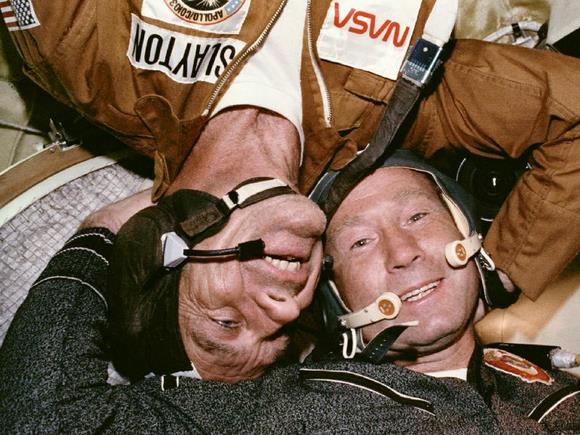[/caption]
On July 17, 1975, something momentous and unprecedented happened: two Cold War-rivals met in space. The Apollo-Soyuz Test Project saw spacecraft from the United States and the Soviet Union docking together in space, ushering in a new era of cooperative ventures between the two countries that once were rivals in the “space race.” Preparing for the mission, the astronauts and cosmonauts had to visit each other’s countries for training, and the two space agencies had to share classified information with each other in order for the rendezvous and docking to work successfully. A few years ago, Tom Stafford, one of the American astronauts said the Apollo-Soyuz mission “showed the whole world that if the Soviet Union and America could work together in space, they could work together on the Earth.”
We almost take this cooperation for granted now, as for more than a decade, American astronauts and Russian cosmonauts have been regularly living and working together in Earth orbit, first in the Shuttle-Mir program, and now on the International Space Station. But, before the two Cold War-rivals first met in orbit, such a partnership seemed unlikely. Since Sputnik bleeped into orbit in 1957, there had indeed been a Space Race, with the U.S. and then-Soviet Union driven more by competition than cooperation. When President Kennedy called for a manned moon landing in 1961, he spoke of “battle that is now going on around the world between freedom and tyranny” and referred to the “head start obtained by the Soviets with their large rocket engines.”
But by the mid-70s things had changed. The U.S. had “won” the race to the moon, with six Apollo landings between 1969 and 1972. Both nations had launched space stations, the Russian Salyut and American Skylab. With the space shuttle still a few years off and the diplomatic chill thawing, the time was right for a joint mission.
The Apollo-Soyuz Test Project would send NASA astronauts Tom Stafford, Donald K. “Deke” Slayton and Vance Brand in an Apollo Command and Service Module to meet Russian cosmonauts Aleksey Leonov and Valeriy Kubasov in a Soyuz capsule. A jointly designed docking module fulfilled the main technical goal of the mission, demonstrating that two dissimilar craft could dock in orbit. But the human side of the mission went far beyond that.
Original News Source: NASA Image of the Day


Gods, it seems only like yesterday. Shame that it serves only to show how short-sighted N.A.S.A. and the American government were by discontinuing the utterly magnificent Apollo programme. The awe and majesty of it still brings a lump to my throat when I think of it and see old footage of a Saturn V taking off. How wonderful it would have been to see what Apollos 18-22 might have discovered and ultimately led to. Magnificent and sad.
Paul.
Ugh! Apollo-Soyuz was the beginning of the end–that is, the beginning of decades of stagnation in manned space exploration–the wonderful ISS notwithstanding.
I still don’t understand what was so great about ending the space race. It didn’t end because the US won it–although the US had checkmate in three moves; it ended because the US offered a draw and the Soviets accepted.
Now the spirit of cooperation prevails over the spirit of competition–as if that’s a good thing! Why is it that for nearly all human endeavors, competition is widely recognized as the proper spur to improvement; yet when it comes to space, competition is bad. Why? I guess it must the hurt feelings, because I can’t think of any other reason–except as an excuse to cut a nation’s space budget to free up discretionary funds for wars and such.
Bottom line: Apollo-Soyuz and the mind-set it represents were a disaster for the American space program.
I don’t think I had seen that picture before. I liked it.
I was at KSC to see the Apollo launch for the ASTP mission and two things stood out.
Firstly that Deke Slayton had shown that if you truly believe in your dream and don’t give up, it is possible to reach your goal.
Secondly, the fact that what was unthinkable a few years before had become reality – the great rivals of the USA and the Soviet Union were working together. Even though there were no in-depth plans to follow up this mission, whatever anyone said about it being a publicity stunt, no-one can deny that it meant a major step forward in collaboration and easing of tensions across the world.
Of course no-one can accurately make long-term political predictions, but this was a very positive event.
As to long-term space activity, the ISS would certainly have benefited from us retaining the Saturn V, whose heavy lift capability would have enabled the ISS to be constructed with far fewer flights. But any throw-away system is still too expensive for long-term use. What we really need is a fully-reusable horizontal take-off vehicle. The prototype of these is Skylon, being developed in the UK by Reaction Engines (see http://www.reactionengines.co.uk/). When the cost of reaching orbit is mostly the cost of the fuel – rather than equipment – then prices will tumble.
If we’re looking for a true way forward, this may well be it.
I remember this a a child. I read the papres ever day & watched the TV, forcing my family to endure my obsession with space.
Warren, the end of the ‘Space race’ wasn’t simply about political posturing (The Cold war went on for another Decdae & a half (ish), as you well know).
As with most grand endeavours,including the old Soviet union, it simply got too damn expensive to maintain.
So this is why so many projects are collaborative & venture capitalists are planning to get tourists married in space.